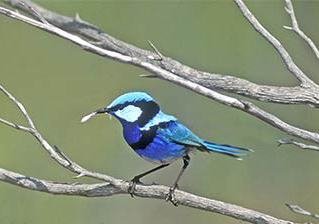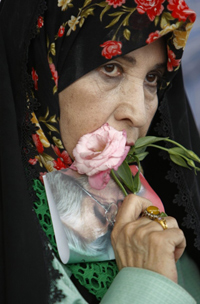Human Flower Project
Saturday, June 20, 2009
Flowers for ‘The Other Wren’
Among one group of Australian songbirds, flower-giving is a cheatin’ thing.

Male fairy wren (Malurus splendens musgravi) with a petal for his mistress
Photo: Grame Chapman
If your partner hasn’t brought you flowers in awhile – or ever – take heart. He may be a purple crowned fairy-wren.
Most fairy wrens, male and female, are renowned for their infidelity. Pairs put on a good front; they raise their young together and together defend the home territory for life. But nosy researchers who’ve tested the genetics of their progeny have discovered that most of their offspring are “illegitimate.” Also, spying human eyes have caught male fairy-wrens taking off to “court” other females, several others in a day.
To turn on the “other wrens,” males have evolved glitzy blue attire and come-ons, including “presentation of flower petals during courtship displays.”
But recently, scholars at the Max Planck Institute of Ornithology in Germany and the University of Freiburg have found one “unqiuely faithful species,” among these Austraian songbirds.
 Purple masked fair wren (Malurus coronatus): homebody
Purple masked fair wren (Malurus coronatus): homebody
Photo: : Doug Adams, for Australian Wildlife Conservancy
The purple-masked fairy wrens apparently do mate for life – socially and sexually. Studying the genetics of 227 purple fairy-wren offspring from 104 nests in Mornington Wildlife Sanctuary, Western Australia, the researches found that only 10 offspring had been fathered by birds other than the “social partners” of mothers.
Fidelity, though, is a flowerless affair. “While male suitors of all other fairy-wrens present flower petals to females during extra-pair courtship, the field researchers never observed this behaviour in purple-crowned fairy wrens in over 300 observation hours.”
Monday, June 15, 2009
The Soft Power of Flowers
Who’ll prevail in Iran? Craig Cramer, looking at confrontations past, finds that flowers usually point toward victory. See Ellis Hollow for more of Craig’s insights and artistry.
 Zahra Rahnavard, wife of Iranian presidential candidate Mirhossein Moussavi, at a June 9 rally in Tehran. Moussavi, who campaigned on broadening the rights of Iranian women, is challenging the official outcome of Friday’s election.
Zahra Rahnavard, wife of Iranian presidential candidate Mirhossein Moussavi, at a June 9 rally in Tehran. Moussavi, who campaigned on broadening the rights of Iranian women, is challenging the official outcome of Friday’s election.
Photo: Reuters
In case you missed it, there were elections in Iran on Friday and a coup d’état over the weekend. Popular challenger Mir Hossein Moussavi, who was Iran’s Prime Minister during the the bloody 8-year war with Iraq in the ‘80s, had strong support among the country’s youth and progressives. He had been expected to defeat incumbent president Mahmoud Ahmadinejad – a Holocaust-denier.
But as Josef Stalin supposedly said: Those who cast the votes decide nothing; those who count the votes decide everything. Some are saying they didn’t even bother to count in Iran. Ahmadinejad was declared the winner by a ridiculous 63 to 34 percent margin.
Friday, June 12, 2009
Falling for Judy Garland
“Over the top” is, for some, an acquired taste—a few trips through the wringer may help get you there.

Judy Garland singing before a wall of roses
“Born in a Trunk” from “A Star is Born,” 1954
Agony has its rewards.
For some fine people (“fine” we can call them now) it builds character; for everyone, it changes capacity.
Like the capacity for Judy Garland. Back when the entertainment industry was still “show business,” she was IT, and we were very young – pre-agony. Her big stagy gestures, bow-shaped mouth painted red, the emaciated body and dyed black hair were horrifying to a ten year old in the suburbs of Louisville, Kentucky. How freaky. How needy! We were trying to acquire a completely different cultural temperature: cool. To be loved while gliding under the radar, not tap-dancing, arm-flinging, hair-twisting for approval. Judy’s blatant cravings – and vaudeville aesthetic – were side-show bizarre. We were kind of embarrassed for her, but mainly we were grossed out.
Wednesday, June 10, 2009
Boulevard of Broken Dreams
John Levett’s rose garden began in another city 35 years ago, but it’s outgrown even history now.

The author’s garden, June 2009, Cambridge, U.K.
Goldfinch, Alister Stella Grey, White Provence, and Fantin Latour
Photo: John Levett
By John Levett
I’m writing this whilst listening to Morton Feldman’s “I met Heine on the Rue Fürstenberg.” These moments come and go. For decades I’ve been overwhelmed by the erudition of the presenters on the Beeb’s Radio 3—Bach’s breakfast preferences, the view from Mendelssohn’s house in Leipzig, where Mahler bought his ties, which shirt Webern was wearing when he lit that fatal fag. I’ve forever wanted that intimate connection with (just) one composer but realised early on that I’m not a one-guy-or-gal guy. In the late ‘50s I was for Wagner, then Mahler, then Vaughan Williams, Stockhausen, Bach (the whole family). Looking at the record collection, I see the only permanent fixture has been Bob Dylan which speaks of something.
Fact is I never stay long enough. Back in 2003 I decided time had come to blitz everything about Wagner’s ‘Ring’ cycle. Two cycles (at Covent Garden and the English National Opera), two CD collections (Solti and Krauss), two video performances (Barenboim and Boulez) and the five volumes of Sabor’s translations and commentary later I could confidently chat about it. Wagner’s the exception. I flit.
I’ve done the same with literature. Virginia Woolf got the ‘Ring’ treatment shortly after; Orwell and Larkin decades before. Feldman’s getting the treatment currently. Next stop Frank O’Hara.

